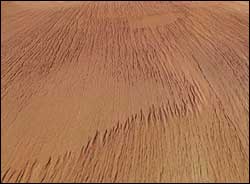’Yardangs’ On Mars

’Yardangs’ on the surface of Mars
These images of ‘yardangs’, features sculpted by wind-blown sand seen here near Olympus Mons on Mars, were obtained by the High Resolution Stereo Camera (HRSC) on board the ESA Mars Express spacecraft.
This image was taken during orbit 143 with a resolution of 20 metres per pixel. This scene shows a structure south of Olympus Mons at 6° N latitude and 220° E longitude, which was probably formed by the action of the wind. Loose sand fragments were transported by wind, and impacted on the bedrock, slowly removing parts of the surface, like a sand-blaster. If the winds blow in the same direction for a long enough period, ‘wind-lanes’, as shown in the picture, can occur. On Earth, the remnants of these features which have not been eroded away are called ‘yardangs’.
Where the surface consists of more resistant material, the force of the wind may not be strong enough to cause this sand-blasting. This might be the reason for the three flat regions (the first in the foreground on the left, and the others top right), which measure about 17 by 9 kilometres.
Media Contact
More Information:
http://www.esa.intAll latest news from the category: Earth Sciences
Earth Sciences (also referred to as Geosciences), which deals with basic issues surrounding our planet, plays a vital role in the area of energy and raw materials supply.
Earth Sciences comprises subjects such as geology, geography, geological informatics, paleontology, mineralogy, petrography, crystallography, geophysics, geodesy, glaciology, cartography, photogrammetry, meteorology and seismology, early-warning systems, earthquake research and polar research.
Newest articles

A universal framework for spatial biology
SpatialData is a freely accessible tool to unify and integrate data from different omics technologies accounting for spatial information, which can provide holistic insights into health and disease. Biological processes…

How complex biological processes arise
A $20 million grant from the U.S. National Science Foundation (NSF) will support the establishment and operation of the National Synthesis Center for Emergence in the Molecular and Cellular Sciences (NCEMS) at…

Airborne single-photon lidar system achieves high-resolution 3D imaging
Compact, low-power system opens doors for photon-efficient drone and satellite-based environmental monitoring and mapping. Researchers have developed a compact and lightweight single-photon airborne lidar system that can acquire high-resolution 3D…





















